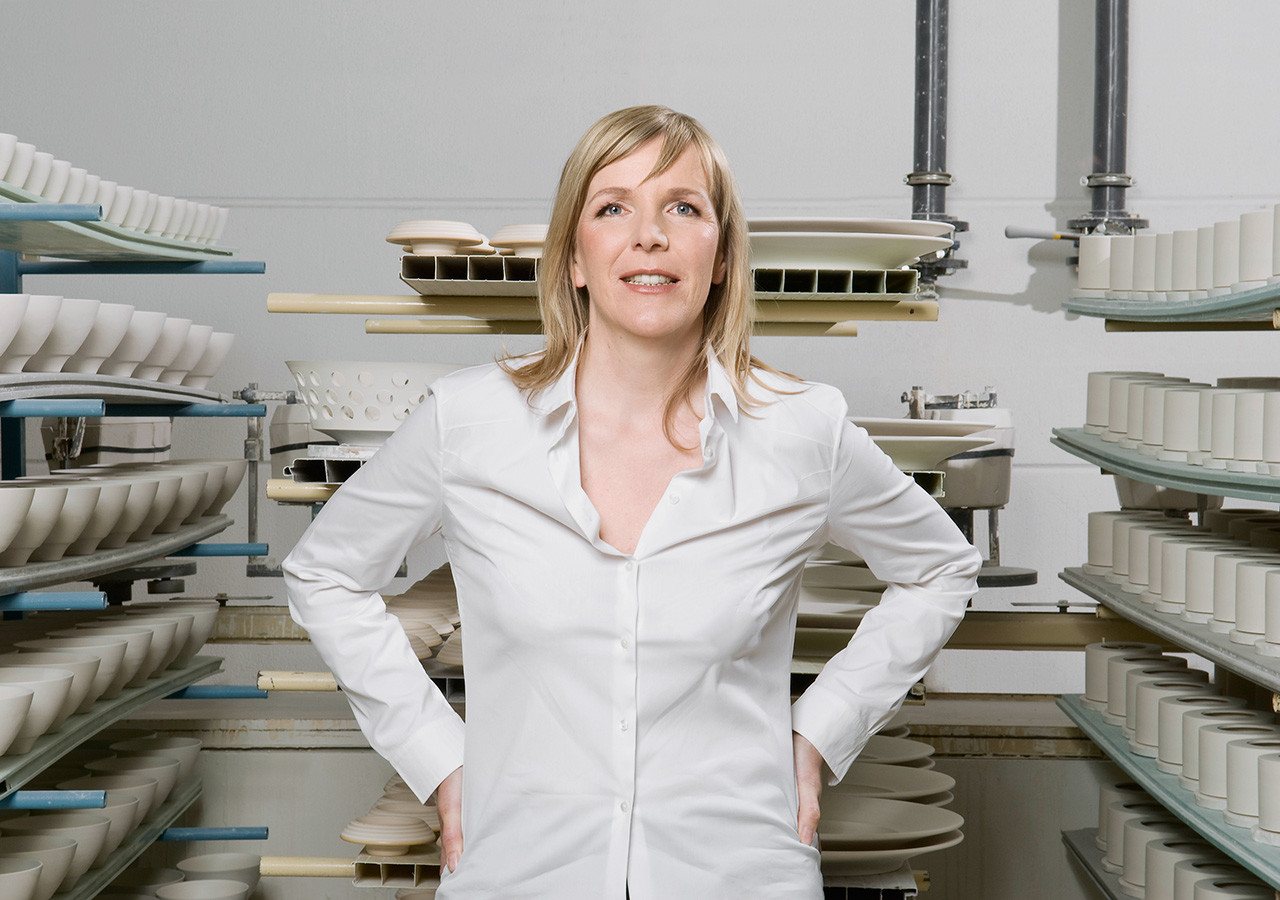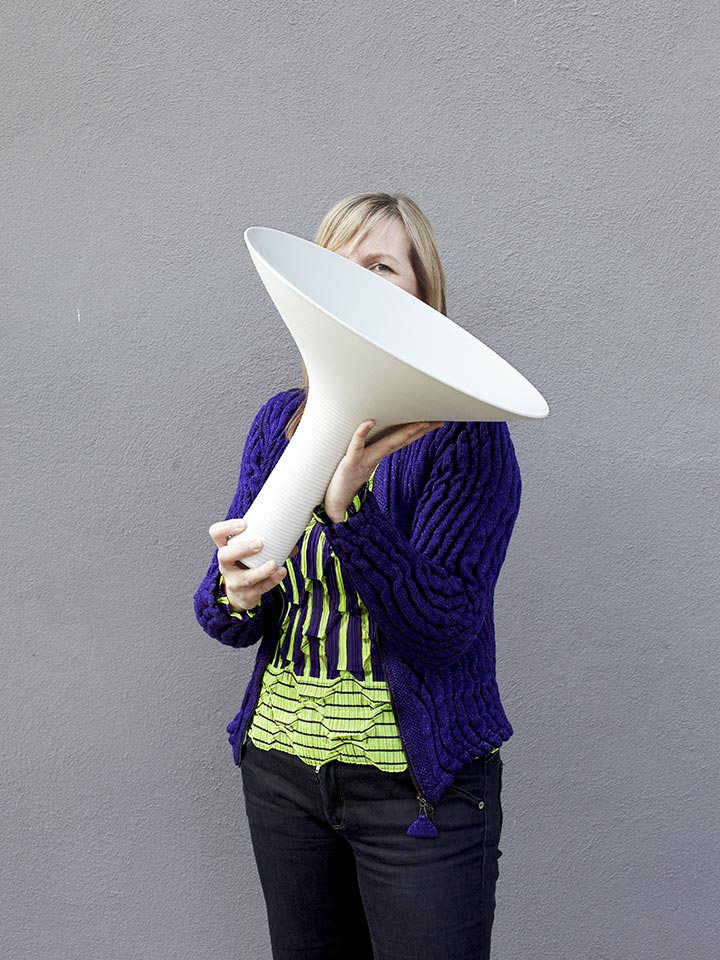An exceptional businesswoman, Stefanie Hering has taken her craft, elevated it to a brand and became well-known around the globe. In our extensive interview we discuss what young entrepreneurs could learn from her.

Image: Claudia Cassagrande
Hering Berlin offers tableware, drinking glasses, table textiles and lamps for “the essence of fine dining.” The Berlin-based brand has friends from Azerbaijan to LA. Hering Berlin founder Stefanie Hering spends some Saturdays in her Berlin flagship store and offers visitors homemade braided bread. She has also prepared tea and baked goods for our interview. Stefanie Hering is radiant with good humor and ready to start in immediately. There are three major topics we’d like to discuss.
1. The Start
Stefanie, what was especially important to you when you founded Hering Berlin? “Do you mean when I became self-employed in 1992 after nine years of, incidentally, the most thorough of educations, or do you mean when I started the brand? That was in 1999.” Both, I asked, and if there were differences. “Of course, admittedly! I gave myself a year to start with. A year to find my customers, to show the world who I am and what I do. Just me, with my workshop. Then in 1999 the fusion into a trio.” More on that later. “That was the actual founding of Hering Berlin. Then it was a matter of anchoring the brand.”
That means, right from the very start, you were thinking like a business woman rather than only as a creative? “Yes, naturally!” She removes the distinction. “You have to be entrepreneurially creative. Right from the get-go, it was clear to me, ‘I have and am managing a small company’. That includes the creative work and the task of keeping the books, right up to filling out everything, the customs’ documents when I sold pieces, for example, in the US.”
In the early years, how important was the outward portrayal of the brand? “I thought about it right from the start, you have to! In 1993, I was already appearing at trade shows in New York, Tokyo, Frankfurt. Immediately, I had to pay attention to how my exhibition stand looked, what about my corporate design – even as a one-woman show. Business at the trade fair was another thing. Contracts were signed. Today, it’s purely representation trade fairs and the business takes place afterwards. But no matter what, you have to pay attention to how you present yourself at the exhibition stand. How I’m dressed and how are my wares being seen. How I speak to my customers. How do I invite them – which cards do I print. All this has to speak in your favor. And when you’re doing it, you’re creative!”
So you planned to become international right from the very start? “During my training I worked in a business, and I have considered, ‘How would I do that later on? How will I sell?’” Not at all the local potters’ markets, at any rate. It was clear to her: “I’ve already got to open up other markets for myself. I’ve got to go beyond German-speaking countries. I want to raise myself up to a certain standard.”
That sounds unusually ambitious. Let’s ask a personal question. Is there something, perhaps, in Stefanie Hering’s background, her Swabian roots, that have given her a special talent or a particular drive and entrepreneurial spirit? “Sure. Hard work and talent.” She shrugs her shoulders as if it’s obvious. Then she adds with verve, “What’s driving me is this, ‘If a country trains me in a craft, then I must be able to make something of it! I want to earn a living from it.’ I had this really super-charged training in this craft. And I wanted to be successful with it.” She looks happy, triumphant, “That’s why I’ve taken this year for me – with the intention of showing the world how it could look.” Does she have a solid tip for young people who want to go into business? “Yes. And what’s important is to ask very openly, then readjust. Don’t make yourself a slave to your customers! But accept criticism. Stay true to yourself and your own convictions. Find out where your markets are, and make your products tasty for them.”
2. Set up and development
Stefanie, you’ve already answered many questions about establishing a brand. For you, it sounds very direct and linear. But are there or were there things that you regret? Mistakes, under or over estimations or perhaps nasty surprises? She laughs heartily. “Sure! All the time! Always!” Apparently, a great deal comes to mind. “Trial and error!” Examples? “A huge commission. A hotel customer in Asia wanted the full setting, so we tailor-made a banquet collection. When I look at it today, I wring my hands! Only yesterday, Wiebke and I wondered how we could have thought that … or some brochures for retailers. You never quite know if it’s right.” Then she sums up. “But I believe we didn’t make any really fundamental mistakes. Perhaps that’s down to the fact that we finance everything ourselves. And make all the decisions ourselves. You’re accountable for everything.”
Does shared responsibility help to avoid mistakes? “Yes, of course. Sometimes we really wrangle. We’re jointly responsible. We’re three very different characters and everyone has their area: Wiebke (Lehmann) does marketing and distribution, Götz (Esslinger) takes care of the trade shows, Corporate Design and finance, and I do design and production. And show my face.”
Have your tasks in the daily running of things changed? “You need to show your face, and not just as the boss. It’s always about how you are remembered. You only stay in someone’s memory if you are honest. When you know what you’re talking about. That’s true for Sepe here in the shop” – she smiles at the salesman, whom I know from the latest photographs on her blog – “It’s true for each of us. After all, it has become extraordinarily hard for us. In our segment, you’ve got prestige customers and design customers. But the question is always the same. For whom am I of interest? Before, you could make five year plans; today, you can be glad if you’ve got perspective on just one year. Planning of a financial base revenue is almost impossible.”
With a view towards this development, as a businesswoman and creative director, what is different for you today than it was before? “That’s quite a slog.” She sighs. “The opponents that you have today – the competitors – we’re not competing fairly anymore. That was different 22 years ago. Above all in our difficult discipline, the crafts.” Now, Stefanie Hering looks serious, almost subdued, “I don’t think that’d end up again where we are today. For an individual contender, it would be utopian. Double as a team.” She takes a realistic look. “The buying behavior has changed completely today. The points-of-sale aren’t what they used to be. Online shopping is growing, and becoming more random and qualified specialist shops are few and far between.”
None of that sounds very encouraging. Is the outlook bleak for entrepreneurial youngsters hoping to follow in her footsteps in the creative crafts?

Image: Bene Ochs
3. Perspectives
Stefanie, do brands like yours still have a chance today? “You should never give up hope! What’s important is that you create something that uplifts you. And you’ve got to put it across in a compelling way. So people take you seriously right from the start. It can’t look like a hobby. Professionalism is required. And it starts with your voice mail message …” She recalls details that she placed emphasis on from the beginning. And, “You have to tell a story with your work. And find someone who opens up and listens.” In the beginning she was annoyed about incorrect reporting („pottery shop” is a catchword) so she took the initiative herself and has long been employing writers and journalists who come to see her operation, listen and ask question in order to write professionally and accurately about Hering Berlin.
What is different today from how it was ten years ago? “Our markets change and shift continually. Spain was really important in 2005, Croatia, too, and now they’ve just about dried up. Today it’s Azerbaijan, Kazakhstan and Russia, though now of course that’s dropped off with the Putin crisis. And L.A. is really coming on strong now. Austria, too.” She comes back to the idea of the team again and again. “Everything depends on us having good people. Especially internationally.”
Stefanie, could you please summarize for the imaginary, young entrepreneur who is unfortunately not sitting next to us. (“Gladly!”):
How do you build a brand
1. “First of all, have fun. If you don’t have fun in your work, then please, hang it up. That’s always been our credo. You have to be happy when you get up in the morning. Otherwise, you won’t be able to bear the amount of work or the stress level. Part of that of course, is good company morale.”
2. She goes seamlessly into tip number two, and it’s no surprise. “Setting up a company like this can only be done as a team. A team needs a leader and people who want to be on it – and of course to work with their heart and soul. So look for good teams! And work out good contracts with clear areas of responsibility. Desire to work together for a common goal. Desire to conquer the world!”
She laughs. Stefanie Hering is a person who loves success. You can feel her drive to conquer the world. “Look, what’s super is that I would never in my life have thought that I’d see so many countries as a potter. In March …” no, now we’re off the record. Only this thing: At Maison&Objet in Paris (January 23–27, 2015) the master potter will present new, oriental décor. Tip three? She says it forcefully:
3. “The obligation isn’t always easy, but you must – and that’s really important – must believe in yourself. And in what you’re doing. That’s the most important thing! Stay true to yourself. Accept constructive criticism, as I said, but process it within your own thought.”
Then she tells me about a “big piece” that they no longer have in their program at Hering Berlin, because its sheer size means it’s impossible for her to handle. But in a production run the day before, it “collapsed so brilliantly,” that she’s even happier about it. She shows me quickly, one more time on her iPhone, smiles, grabs her things, says “bye” to Sepe, gives me a kiss and runs off for the train to Hamburg. It’s a wonderful day.
Thanks so much, Stefanie!
Published first on the Edenspiekermann blog.
